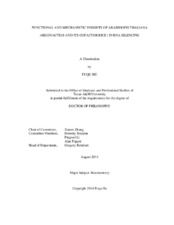| dc.description.abstract | Argonautes (AGOs) are central components in RNA-induced gene silencing complexes (RISCs) and control almost all aspects of developmental processes in eukaryotes. Study on AGO proteins not only elucidates the fundamental mechanism of RNA silencing but also provides a new opportunity for developing novel therapeutic strategies.
Arabidopsis thaliana encodes nine functional AGO proteins among which AGO10 is genetically involved in shoot apical meristem (SAM) development, yet the underlying mechanism remains elusive. Because AGO proteins recruit small RNAs (sRNAs) to execute their regulatory functions, we have managed to clone and sequence the sRNA library from AGO10-immunoprecipitates. We have found that AGO10 specifically binds with miR166/165, two miRNAs with a difference in a single nucleotide but targeting the same homeodomain transcriptional factors (HD-ZIP III). Further biochemical studies reveal that the strong preference of AGO10 to miR166/165 is due to the unique duplex structure of miR166/165. By a series of mutagenesis we were able to pinpoint the critical secondary structures which contribute to the specific AGO10-miR166/165 interaction.
We then took combination approaches of genetics and biochemistry to study the biological role of the specific AGO10-miR166/165 association. We found an increased level of miR166/165 in ago10 mutants and the ectopic accumulated miR166/165 is redirected to AGO1, a principal regulator in various RNA silencing pathways in plants, leading to repression of the HD-ZIP III transcripts and consequently the defective SAM in the mutants. However, when wild-type AGO10 and miR166/165 target mimicry (MIM166) were introduced to ago10 mutants, accumulation of both miR166/165 and their targets were restored to wild-type levels. Thus we propose that AGO10, in contrast to all other characterized AGOs, functions to antagonize miRNA while protecting the miRNA targets.
Next we explored how RISC is assembled using AGO10 as a platform. By proteomics approaches, a number of AGO10 cofactors including RISC-implanted clearance exoribonuclease1 (RICE1) were recovered. RICE1 turns out to be a 3’ to 5’ single strand sRNA specific exoribonuclease. Genetic and biochemical studies of RICE1 and its paralog, RICE2, implicated their important role in RISC activation by clarifying miRNA* during the RISC assembly. Thus, the result provides new insights into how RISC is activated after miRNA/* duplexes are loaded into AGO proteins. | en |


